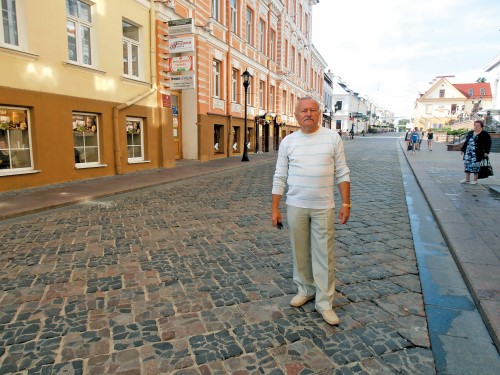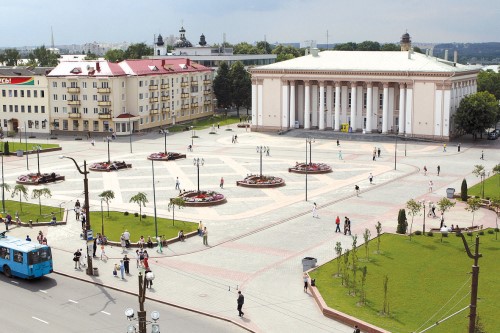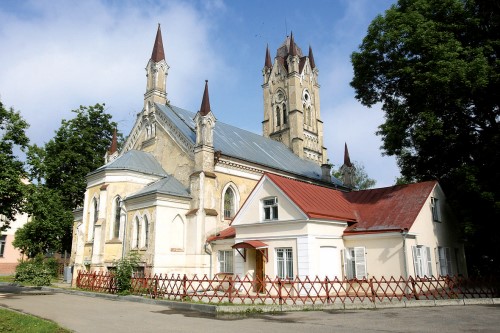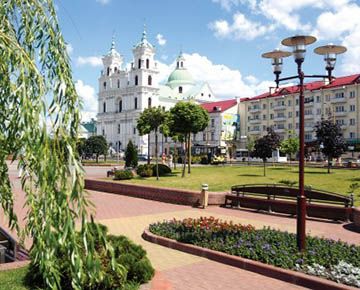
Grodno’s chiming tower clock is the most ancient in Europe, located on St. Francis Xavier Cathedral. The calling card of the city is 400 years old and stands on Sovetskaya Square. It’s here, at noon, as the clock strikes, that I meet Victor Sayapin.FIGURES
63 Grodno sites are included on the State List of Historical and Cultural Treasures
As we approach a picturesque public garden, he tells me, “Well-known St. Mary’s Church once stood opposite the cathedral. Last June, we unveiled a memorial plaque for the lost church. It endured much in its lifetime, having been constructed in the 14th century, and been destroyed by frequent fires. During the time of Soviet atheism, it was demolished, leaving the site bare for more than half a century…”
I try to take a good photo of the memorial but others keep stepping in front; the location is really popular, so it’s quite crowded.
Moving on, we reach house #1, on pedestrianised Sovetskaya Street: the former palace of the Sanguszko princes. Constructed in 1742, Mr. Sayapin explains that a tavern once stood there, famous from the 16th century onwards. A QR-code is mounted on the corner of the house and he asks if my phone can access the Internet? We take a photo of the QR-code and are soon downloading information on the site.
“Similar QR-codes have appeared all over the city recently and are installed on 40 of the most significant historical and cultural sites,” Victor explains. He helped create the mobile ‘guides’, which include illustrations.

Grodno’s central square as it appears today
We pass some beautiful granite columns, which prevent traffic from entering the pedestrianised street. “All kinds of transport used to pass here, including taxis, wedding motorcades and jeeps,” recollects Victor. “However, we installed these two years ago, with granite vases of flowers placed at the side entrances, making the street truly pedestrian.”
It’s a beautiful place, with stylised lanterns, young trees with low canopies and a great many flowers on windowsills. Tourists are photographing a huge panel on the wall of the former Dominican monastery, and on Grodno men’s grammar school. “Fifteen years ago, well-known artist Alexander Silvanovich moulded birds to symbolise various people living in Grodno,” Victor explains. “This, alongside many other city decorations, was presented at the Republican Festival of National Cultures, which is held on a large scale in the city every two years.”
Of course, nothing is perfect. The historical building before us includes a shop with a modern door. Mr. Sayapin cannot hide his indignation as he denounces the decision. “They bought an apartment, cut a new entrance, and made a footwear shop. It’s difficult to imagine what will be the result if other businessmen do the same. What will happen to this monument of 18th century architecture?”
The undesirable presence of a great many shops on the ancient street is noticeable. There’s a fashionable salon, outlets selling branded European clothes and a lingerie boutique, all of which could easily be housed on the parallel streets. Victor believes that museums, galleries, showrooms and small hotels would be far better suited to the old street, saying, “I hope that someone will implement this idea.”
The longer I spend looking, the more I realise that Grodno is a city of craftsmen. You can easily find wonderful hand-made souvenirs.
We pass the former palace of the noble Sapega family, constructed in 1795. Further on is a monastery building, the Church of the Holy Spirit and a hospital constructed at the request of Queen Bona. Surprisingly, all were built in the first half of the 16th century, yet look fresh, as if built last week.
We turn the corner, and my guide invites us into a pharmacy, which he tells me is of medieval construction. Mr. Sayapin directs my attention to cobble-stones visible in the floor. His argument is convincing. There’s something similar at the end of the pedestrianised street, inside a popular local pub. Victor notes, “Many years ago, there was an automatic machine baking doughnuts here, with a standard cafeteria beyond.” These days, the interior has been restored to an antique appearance, with open brickwork walls. In fact, it’s the former Masalski family home, a palace dating from the 18th century. The pub is in the basement and is a real gem.
The Palace of Vice Governor Konstantin Maximovich dates to 1803. “When the city was seized by the French, in 1812, Jérôme-Napoléon Bonaparte, the King of Westphalia, located his staff in this building. Napoléon Bonaparte’s younger brother was so impressed by Grodno girls, ever famous for their beauty, that his desire to be at war slowly faded and he arranged various balls here,” the historian tells me, as we walk around the well-preserved walls of the building. “Why did the French lose the war? Because they liked girls so very much!” Victor Sayapin smiles. It’s a well-known saying in Grodno.
On the other side of the pedestrianised area is a bank; at first sight, it appears modern but is out of tune with its surroundings. “In the late 1930s, it was decided to reconstruct a hotel called both ‘Switzerland’ and ‘New York’, in the constructivism style,” Victor explains.
The Detsky Mir department store doesn’t fit the architectural style of the ancient street. About five years ago, it was modified, with an attic floor constructed to chime with neighbouring buildings. Victor explains that another building has waited 30 years to be reconstructed. Peering through the huge windows, we can see that it’s empty inside. “In the 1970s, it housed the most popular restaurant in the city, called Bialystok: stylish and serving good cuisine. In fact, a new public catering outlet is due to now launch here.”
On my next Grodno trip, I might be able to sample a cup of coffee there, amidst an ‘olde worlde’ atmosphere.
FRESH VIEW ON OLD CITY
Historical centre both beautiful and functional
Grodno is unique in Belarus as only city to have preserved its medieval structure of streets and squares, as formed throughout the 15th-19th centuries.


Architectural silhouettes of the city
Today’s historical centre of Grodno occupies 302 hectares. It is not only the centre of administrative-public life but is busy with traffic and is a dense residential area. Gennady Talamanov, the Head of Architecture and Town-planning for the Grodno City Executive Committee, and the main architect for the city, tells us, “Every year, we’ve been reconstructing dozens of historical buildings, bringing a ‘facelift’ to ancient part of the city. Over 500 municipal and private apartment blocks are located in the centre, with most having been constructed at the turn of the 19th-20th centuries. Each year, we’ve been making major repairs on 4-5 apartment blocks and to the facades and roofs of 15-20 further blocks. Across 17 sites, we’ve spent Br18.6 billion, in the historical centre of the city, and have plans for seven new sites.”
Grodno’s Old Castle is next in line for restoration, being listed within the governmental programme Castles of Belarus. Meanwhile, city enterprises are sponsoring the restoration of the Lutheran church. The synagogue’s repairs are being jointly funded by the Jewish religious community of Grodno and by sponsorship.
The city’s suburbs are gradually receiving more facilities, including major shopping centres. In 2005, the norm was just 262.7 square metres of retail space per 1,000 people; now, this has almost doubled, to 519.4 square metres. Meanwhile, public catering employment has doubled over the last decade.
Recently, the main city streets have been transformed, using an open plan ring road to serve outlying areas and ease traffic flow. There are two overpasses, near the railway station and Suvorov Street, and many streets have been converted to two lanes. In addition, there have been major repairs at the railway station.
Public health service buildings have also received attention, being reconstructed and equipped with modern equipment. Repairs are complete at Grodno Regional Clinical Hospital and at Grodno Regional Clinical Hospital of Infectious Diseases, and the Children’s Regional Clinical Hospital has a new building, as well as having its former administrative-medical building turned into a hostel. Grodno’s regional blood transfusion station is now operational too.
Every year, the city acquires new facilities and services. Between 2011 and 2014, Grodno launched four more pre-schools, as well as two secondary schools, a spa-baths complex and two youth centres. Another school is to open its doors in September 2015, while December will see the launch of a new kindergarten in the suburb of Vishnevets.
Of course, buildings should be pleasing to the eye as well as functional, with good evening illumination of facades and attractive grounds. The city is also known for its sculptural compositions, which are regularly supplemented.
By Julia Popko











